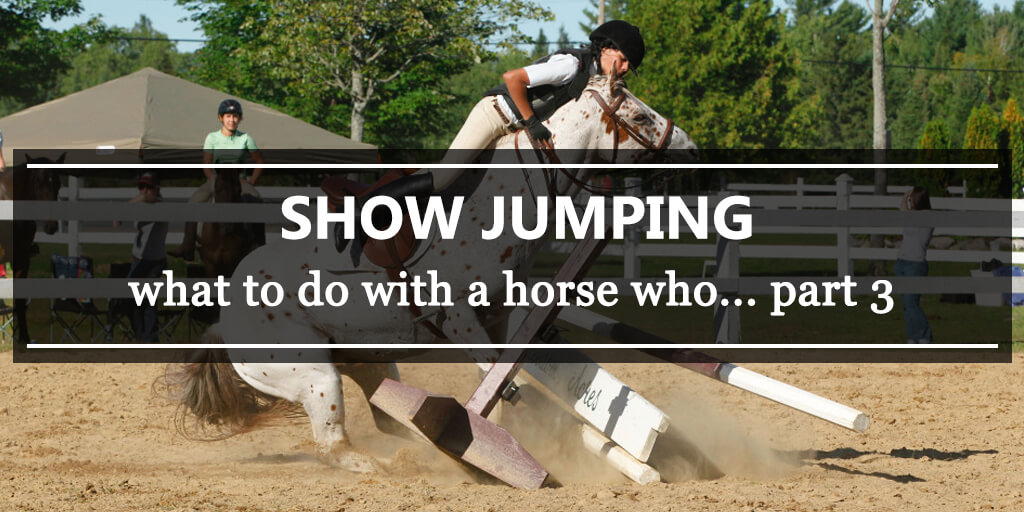
background source: leonierobertsphotography.wordpress.com
There are many causes for which your horse does not want to jump over an obstacle, which we mentioned in two previous articles HERE and HERE. An effective rider is capable of identifying the source of such situation and what to do to change it. In order for everybody to be able to become such rider, we will try to take a closer look at yet another, most common horses' "problems" that show while jumping. We will try to show you solutions so you could change the unpleasant (for both the rider and the horse) situation.
Today we will discuss cases when:
1. Horse pulls more and more with each obstacle.
2. Animal behaves improperly after jumping (eg. kicks).
3. Horse perks his head.
4. Horse raises his front/hind legs too slow while jumping.
5. Horse jumps flatly.
Horse pulls more and more with each obstacle
Causes:
Often, horses of sturdy temperament tend to give in to emotions and they get excited while approaching obstacles. With each jump they go harder and it becomes more difficult to control them. The cause is their personality, but also lack of enforcing the applying rules from the horse, thus insufficient rider's abilities, who allows such behaviour.
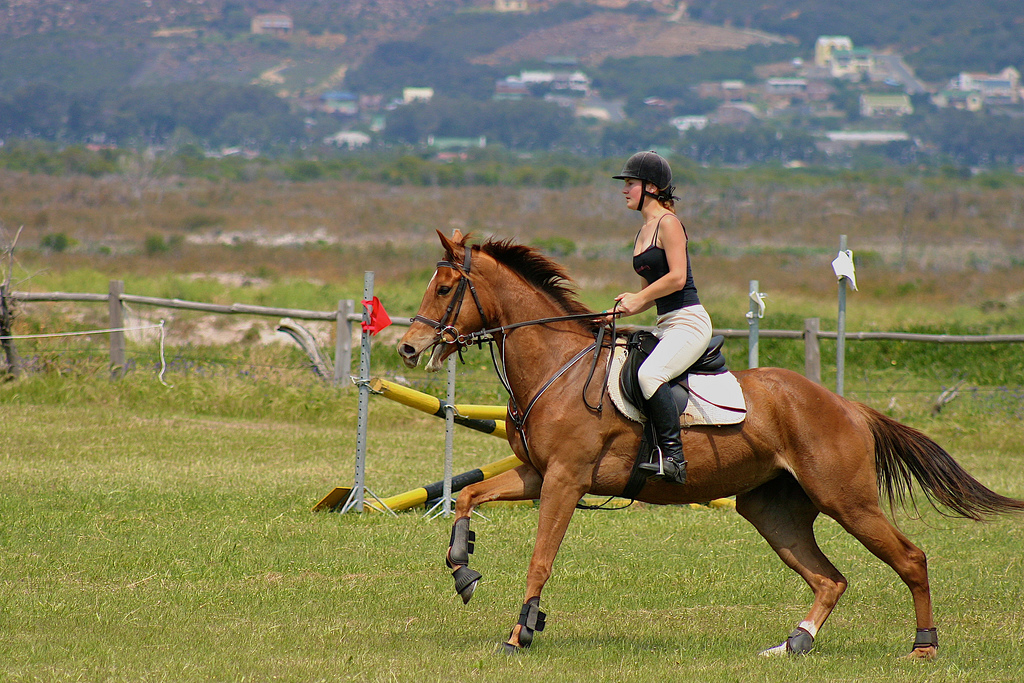
Photo's author:
Rob Lith |
CC BYSolution:
Your goal should be to teach your horse how to focus on jumping and on your commands. Below we present you with an exercise that will help you "control" your horse, who is particularly energetic and seems to have too much strength, usually trying to use it against the rider.
Note!
However, remember that a horse who pulls just not being able to control his energy is one case, and a horse who makes a "fifth leg" in his muzzle and leans on the bit is a completely different case. Today we are discussing only the first situation.
Exercise: regulating the pace in circles
- Arrange a gymnastics line composing of two obstacles, for example of straight rails of medium height (60-70 cm) at a distance of 3 or 4 foules. Arrange the obstacles in such a way that when you land after the second one, you would be able to land in a corner.
- Jump the line at a canter.
- Right after the second obstacle, still riding at a canter, ride on a volte, preferably performing it in the aforementioned corner. Stay on the volte until your horse calms down and shifts into a suitable for you pace at a canter.
Why do we keep the horse at a volte? Because you want the horse to understand that you will keep him in the circle until he stops speeding and starts listening to you signals. For some horses just a few circles will be enough, others will need a dozen or more. You cannot forget that you cannot let your horse to switch to a trot on his own - you decide when it happens. Until then, keep the impulse at a canter.
When the horse finally "lets go" and starts reacting to your signals, maintaining calm and even canter, you can switch to trot, or even walk. It is good to immediately tap or stroke him, so he knows you are proud of him.
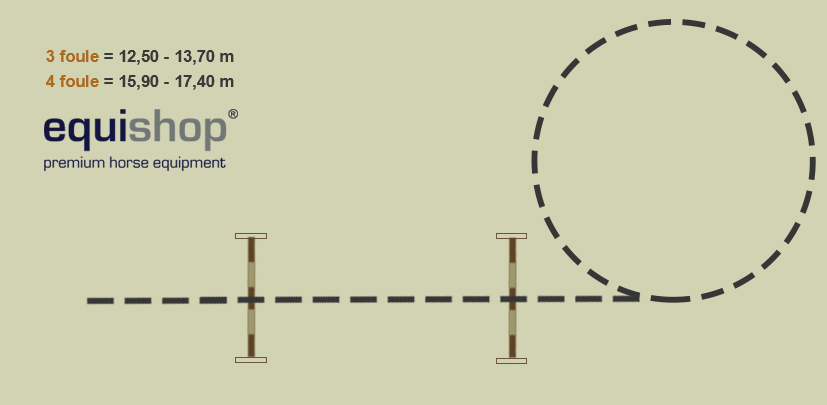
Distance between the obstacles - 3 or 4 foules
It is good to perform this exercise a couple of times. Each time reward your horse with relax and patting him after you have obtained a desired reaction. Also remember that it is very important to keep an even circle in this exercise. How big should the circle be? It depends on your horse - adjust it to his possibilities, but do not bend him too much so he does not lay on a side while speeding at a canter on a teeny tiny volte. The horse's bend should be such that it prevents stiffening and blocking the horse's neck and jaw. You cannot tug, alternatively pulling left and right reins, showing your dissatisfaction. You have to be very patient, do not stop him forcefully, only watch so he walks on a determined route (on a volte) and move at a chosen by you gait (canter). The horse will eventually give up fighting when he sees that no harm is done to him and he will start keenly cooperating in order to stop revolving in a volte.
Kicking and other ideas after jumping
Causes:
- If you are working with a young horse, you have to keep that in mind that young horses usually see jumping as something amusing and exciting. They cannot contain their emotions, and they show them by kicking, bucking and other revolutions.
- If you are working with an experienced horse - maybe it is his way of getting rid of the rider from his back, a way that has always worked since he started doing so. At the same time, it prevented him from jumping, which he does not like.

source: hoofease.com
Solution:
- When you are working with a young horse, do not try to punish him for his behaviour. If you have proper balance, kicking and bucking may be irritating, but they will not do you harm. After a jump just try not to pay attention to him, but minding so he walks in the chosen by you direction. The horse will eventually grow out of this. But until that happens, it is good to occupy his attention in order to encourage him to drop such behaviour.
- If you encounter a horse who opposes your control and constantly tries to get rid of you, it is also not worth trying to punish him, but command him to ride a bit faster and on a set route. A great exercise here will also be: regulating the pace in circles, which also young horses might perform.
- Remember that it is good to acquire a safety seat - that means: shift your legs slightly towards the horse's shoulder blades, lean strongly on the stirrups and the horse's sides, and slightly lean your torso backwards from the vertical. Such seat will help you leave possible oppression intact.
- Usually it is also useful to introduce frequent shift canter - trot - walk - trot - canter, or riding after a jump on a volte with a single pole. Such tasks force the horse to focus after jumping.
Perking his head
Causes:
There is a small group of horses who hold their heads high because that is conditioned by their race and specific anatomical structure. However, most of horses show in that way tension and accompanying stiffening.
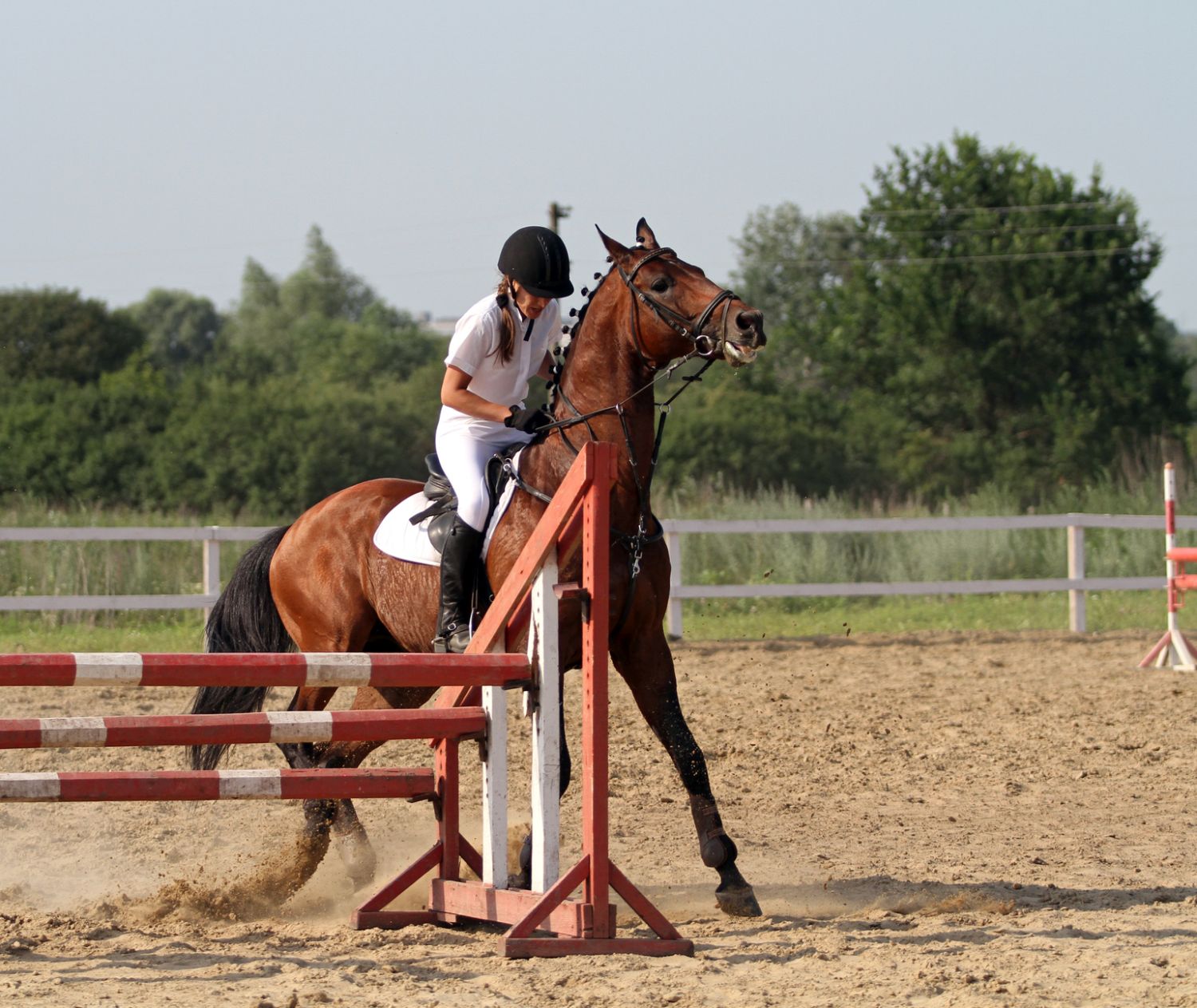
source: ecoequine-wordpress-com
Solution:
- If the horse shows such behaviour not only while jumping - you would have to go back to the dressage basics with him, forgetting about jumping for some time. Work with such horse requires a separate article, so in short, we will tell you that it is good to work with him on lunge, volte, for example exercising "chewing from hand", trying to obtain full relaxation of the horse during training, so also lowering his head and lengthening his neck, sticking his back muscles out. If the horse formerly did not have such problems, and it appeared only recently or when specifically you started riding on him, it is worth asking an experienced instructor for help. He or she will help you learn if you or your behaviour is not the source of the problem, for example if you have a wrongly fitted saddle.
- If your horse perks his head only while jumping, riding between the obstacles, it is not worth using inventions (for example: a martingale or drawreins), because it will result only in temporary effect and will not guarantee that the problem will disappear. In such situation, you should invest in relaxing exercises, for example - while trotting on cavaletti, give the reins away to the horse so he can lower his head.
Below we present you with some other exercises that may have the desired effect.
Exercise: pole before and behind an obstacle
- Arrange small straight rails (40 - 50 cm) and set a pole for trot before it (2,10 - 2,5 m from the straight rails). Behind the obstacle place one pole on cavaletti (or some other platform) at a distance of 2,85 - 3,30 m from the straight rails.
- Approach at a trot, trying to perform the whole exercise - from its beginning to the very end - at the same pace.
- During a jump, the horse should be focused on a pole behind the straight rails, which will result in him having lowered his head and neck so he could see it.
Exercise: rank with poles between the obstacles
We discussed this exercise in the article about jumping gymnastics (you can find there some more of interesting tasks). It is way more difficult than the previous one, but it has the desired effect if it is done properly.

The above example requires constant focus and attention from the horse. You pet has to constantly pay attention to where he puts his hooves in the next step. Arranging such rank is not easy, because the distances have to be precisely adjusted to your horse. Thus, it is worth starting from a rank with low obstacles (30-50 cm). As the time goes and your horse feels more sure on the training, you can add another parts of the rank. A well-balanced steed is capable of performing the above exercise without accelerating, slowing down, losing rhythm or impulse.
Horse raises his front/hind legs too slow while jumping
Cause:
This problem usually concerns young horses. Many of them are initially so preoccupied with for example the mere work and position of their front legs that they forget about the proper take-off of their hind legs and "folding" them during a jump :) Sometimes, reversed cases happen, when horses cannot catch up with work of their front legs, usually throw the poles off.

Photo's author:
Kathryn Adams |
CC BYSolution:
In this problem's solution the main helper is time, of course the time spent on trainings. Young horse will "get" all his limbs with time :) In order to pick up its pace and help him deal with this problem, forming proper reactions, it is worth trying the exercises described below.
Exercise: line jump-take-off
- It is worth beginning the work from the above mentioned exercise: pole before and behind an obstacle. That will allow your horse to become familiar with such arrangement and after a few jumps, you will be able to replace the cavaletti with another straight rails at a distance of 3,00 - 3,50 m (jump-take-off).
- Once the horse gets used to two straight rails, it would be possible to add next elements even up to 5 obstacles in line. It is important that the distance between each is equal and that all the obstacles have the same height. Regularity is important if you want your horse to focus solely on his jumping technique.
- Approach such arrangement at a trot - rhythmical and relaxed.
- The obstacles have to be low (30-50 cm).
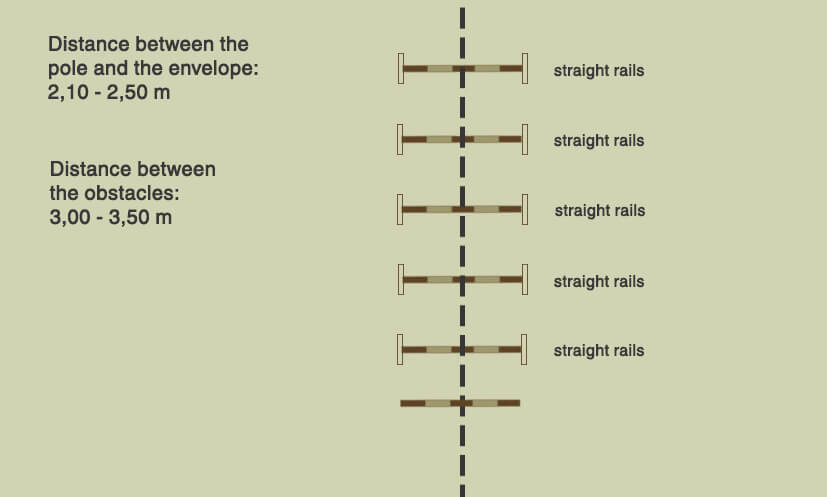
Exercise: line for one foule
- Arrange a line of 4-6 low straight rails (30-50 cm) at a distance of 6,00 - 6,50 m (one foule).
- Place a pole-pointer before each straight rails at a distance of 60 cm from the obstacle.
Pole-pointers places slightly before an obstacle forces the horse to shift the gravity back, at the same time raising his front limbs faster while jumping.

Flat jumps
Causes:
Horses who do not work with their backs jump flatly. They rely only on the rapidity of bending their front legs. There are many causes of such situation: horse's stiffening and lack of relaxation, racing past etc.
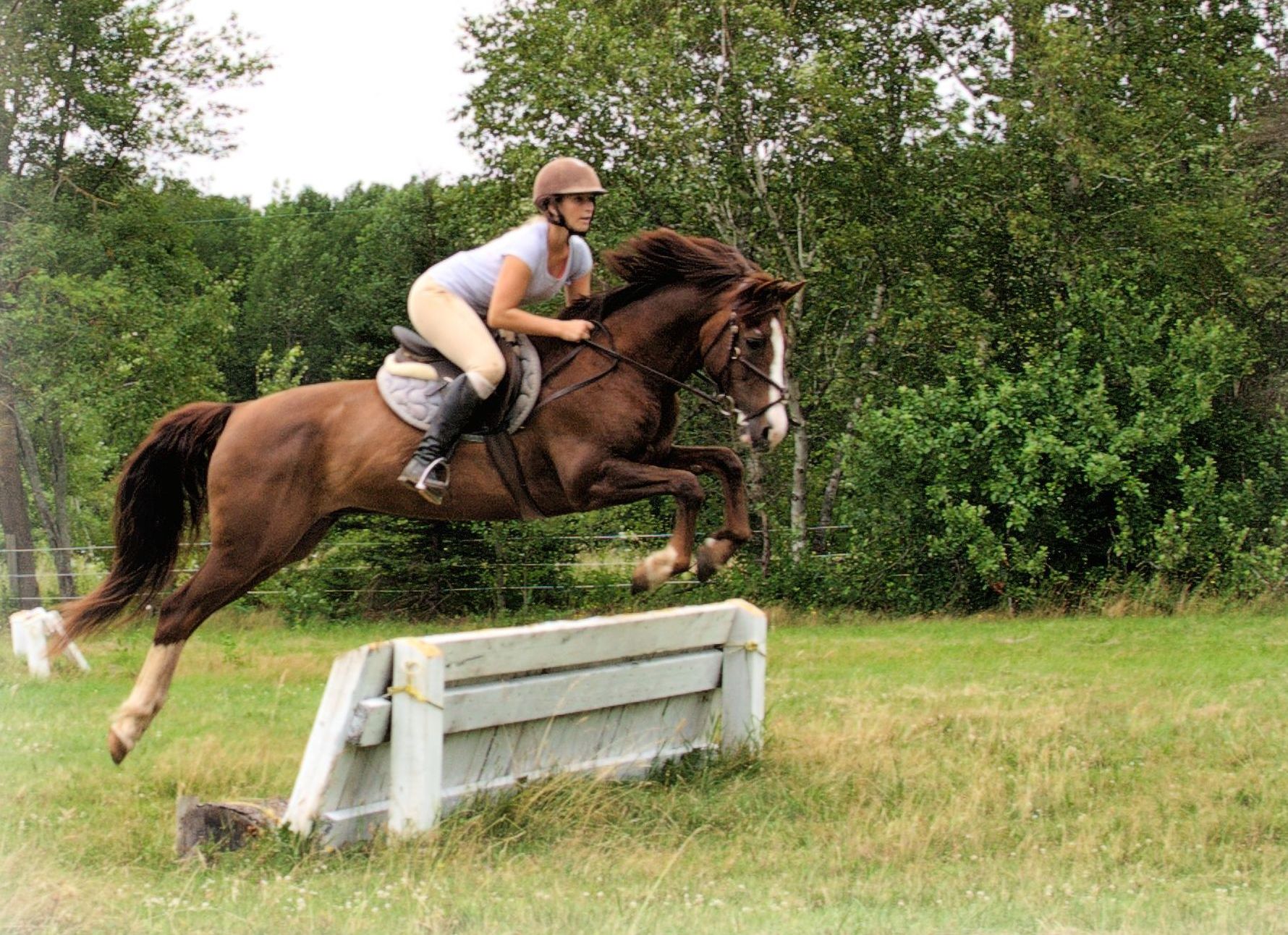
Photo's author:
bambe1964 |
CC BYSolution:
Your aim should be to force the horse to increase his back muscles work during a jump and learn how to bascule. What is basculing? It is forming the horse's body in an arc while jumping - bend of the spine on all its length from the occiput to the tail. Proper bascule is characterised by the fact that the distance of take-off before the obstacle is equal to the distance of landing behind it. It increases efficiency of jumping, because the horse uses his whole musculature.

Basculing a horse, source: vk.com
Below we present one of the exercises that will help you improve your horse's jumping quality.
Exercise: double envelope with poles
- Place two envelopes close to each other, but leaving a distance of at least 15 cm between them (so the poles can fall and not get blocked). The envelopes' height in the centre might reach approximately 50 cm, while the higher ends of the poles of each envelope should be pretty high. Such arrangement, like an oxer, will force the horse to jump high and wide and at the same time requires the horse to jump in one place.
- Set the pole before and the pole behind the obstacle at the same distance - 2,50 - 2,80 m.
- Approach at a trot at a slow pace in both directions.
- As the time goes and the more jumps you jump, you can ask your helper to widen the obstacle of more or less 10 cm. However, do not change the ground poles' position. Why? Because the horse is supposed to learn that a pole that he touches always falls down. Poles that are too blocked might even cause the horse's fall, and that is definitely not your goal :)
- If your horse perfects this exercise, you can make it more difficult for him by replacing ground poles with cavaletti.
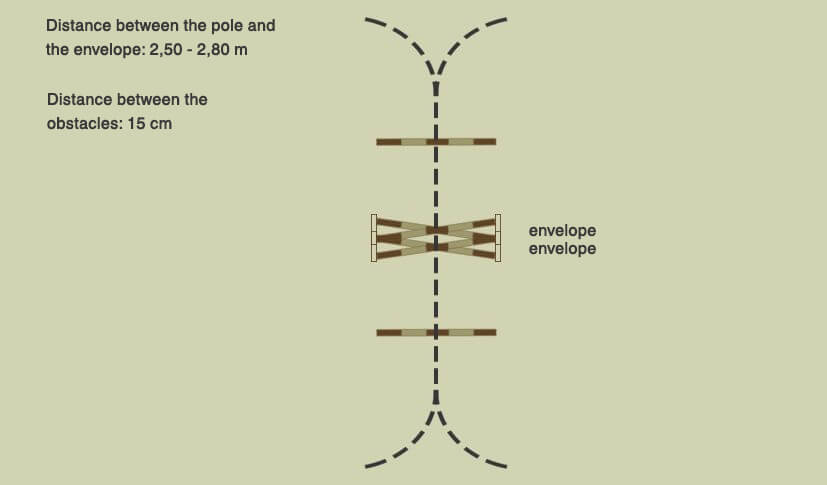
This exercise will teach your horse that he is supposed to perform each jump through the middle of any obstacle, trying not to knock the poles and bending his body in an arc while jumping.
Note!
Remember not to exhaust your horse with too many repeats and too difficult tasks, widening and raising the obstacle too much and doing all this during one ride.
Most important rules concerning elimination of the horse's mistakes while jumping:
- Do not jump the whole parkour. Repeating the exercise on one obstacle (straight rails or envelope) of remote height (40-50 cm) will allow you to eliminate the mistakes.
- Do not expect to fix all the mistakes during one training. Usually the horse's improper behaviour has already become his habit. Thus you have to be very patient and prepared that the process of "unteaching" and teaching him new "pattern of behaviour" while jumping might take a very long time (even a year). Everything depends on how deeply the reaction took its roots at the horse.
- It is worth considering if you are not the source of your horse's mistakes. If you lack balance, cannot follow the horse with your body or "give away" your hand to him while jumping, you have to be aware that every jump with you on the horse's back is not a pleasant experience for him. It is worth working on yourself first, preferably with a coach and on a professor-horse (experiences), who will forgive you all your mistakes and shortages.
- If you experience issues with your horse while jumping, often its cause is lack of solid dressage basics and trust for the rider. If you skip certain elements of training, sooner or later you will have to go back to them anyway. Thus, it is not worth losing time on teaching the horse basics again. Try to train your horse step by step, without rushing another phases of training.
Also remember that the very basis of jumping is always a helmet. Thus it is worth investing in a good-quality helmet, which will absorb the impact, having all the necessary safety certificates and meeting all European standards. It is also worth investing in a solid vest, which will protect you from serious injuries during potential falls.
We hope that our tips will prove helpful!



 background source: leonierobertsphotography.wordpress.com
background source: leonierobertsphotography.wordpress.com Photo's author:
Photo's author:  Distance between the obstacles - 3 or 4 foules
Distance between the obstacles - 3 or 4 foules source: hoofease.com
source: hoofease.com source: ecoequine-wordpress-com
source: ecoequine-wordpress-com
 Photo's author:
Photo's author: 

 Photo's author:
Photo's author:  Basculing a horse, source: vk.com
Basculing a horse, source: vk.com

